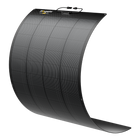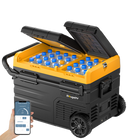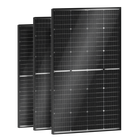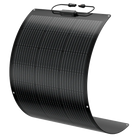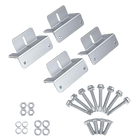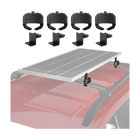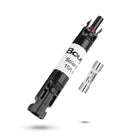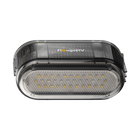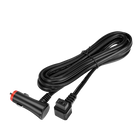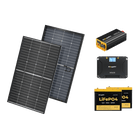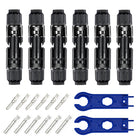What are Thin Film Solar Panels? All You Need to Know!

Although the traditional, bulky silicon solar panels that most people know and use. Actually, the thin-film solar panel is another excellent option with great promise. They are lighter and more convenient, and they can still work well even in weak light conditions, which is a make-up for the defect of rigid solar panels.
Thin-film solar panels, also known as flexible solar panels, are composed of one or more layers of light-absorbing thin-film material that generates electricity.
You might be thinking: What? This sounds not reliable as the solid one. In fact, they are more reliable than you might think, perform well, and have a stable output in low-light conditions.
Read on and discover more about what thin-film solar panel is, how it benefits you, and more!

- What are Thin-film Solar Panels?
- How Thin-film Solar Cells Are Made?
- Types of Thin-film Solar Panels
- Features of Thin-film Solar Panels
- What are Thin Film Solar Panels Used for?
- Benefits of Thin-film Solar Panels
- How to Install Thin-film Solar Panels?
- Conclusion
- FAQs
What are Thin-film Solar Panels?
Thin-film solar panels are pretty thin with each layer of only 1 micron thick, they are even thinner than hair.
Like traditional monocrystalline or polycrystalline solar panels, thin-film solar panels can convert light energy into electricity through the photovoltaic effect. However, a thin-film solar cell is much more lightweight and flexible to install.
Its surface is composed of many light-absorbing films that combine to form a film that is about 300-500 times thinner than standard silicon, which is the outstanding advantage of thin-film solar panels.
It is no exaggeration to say that thin-film solar panels are the lightest panels available today, with each cell consisting of three main components: the photovoltaic material, the conductive sheet, and the protective layer.
In addition to the slim internal design, thin-film solar panels are also extremely durable, as we will expand on in the next article.
How Thin-film Solar Cells Are Made?
Thin-film solar cells are created by depositing one or more thin layers (thin films or TFs) of photovoltaic material onto a plastic, glass, or metal substrate. Typically, each thin-film solar panel is made of three main parts:
- Photovoltaic Material: This is the main semiconducting material and it is the one responsible for converting sunlight into energy such as CdTe, a-Si, or CGIS.
- Conductive Sheet: To stop electricity loss and increase conductivity, a layer of electrically conductive material, such as aluminum, is required.
- Protective Covering: To increase durability and shield the solar module from the elements and thus extend its lifespan, a thin layer of premium glass or plastic is added to the system's top.
Types of Thin-film Solar Panels
They’re four common types of thin-film solar panels typically used in outdoor applications: copper gallium indium diselenide (CIGS), cadmium telluride (CdTe), amorphous silicon (a-Si), and gallium arsenide (GaAs) solar panels. Now, let’s take a look at these different thin-film solar panels one by one.
1. Copper indium gallium selenide (CIGS) solar panels
CIGS solar panel is versatile manufactured by various processes, and implemented in different forms. In addition, the CIGS solar panel is more appealing as a highly efficient alternative to large commercial solar modules.
Some companies are using this for commercial use, which has proved to work well. BougeRV has also released CIGS solar panels for you to install easier and use more happier.
CIGS solar panels are not popular for conventional applications and are mainly used in space applications because of their low-temperature resistance and their excellent performance under low-intensity light conditions in space. The cost is relatively high compared to other technologies, currently priced at slightly more than $0.60/W, but future manufacturers promise to reduce the cost of these panels.
Although CIGS thin-film solar panels are not yet as popular in the market as CdTe panels, CIGS technology still accounts for 2.0% of the PV market share. This is still quite popular as thin-film solar technology, considering that thin-film solar modules hold only about 10% of the market share.
Composition of Copper Indium Gallium Selenide (CIGS) thin-film solar cell - Source: SOLAR ENERGY TECHNOLOGIES OFFICE
2. Cadmium telluride (CdTe) solar panels
CdTe is the second most common photovoltaic material after silicon, and CdTe cells can be manufactured using low-cost manufacturing processes. While this makes CdTe solar panels a cost-effective alternative, they are still not as efficient as silicon solar panels.
CdTe solar cells are fabricated using an absorber layer containing a p-n heterojunction that combines a p-doped CdTe layer with an n-doped CdS layer, which can also be made from magnesium zinc oxide (MZO). To deposit the material on the substrate, manufacturers use vapor-phase transport deposition or proximity sublimation techniques.

Composition of CdTe thin-film solar cells - Source: SOLAR ENERGY TECHNOLOGIES OFFICE
3. Amorphous silicon (a-Si) solar panels
Amorphous silicon (A-SI) is a kind of allotropic amorphous silicon, which is the perfect thin-film technology so far. Thin film silicon substitutes traditional wafer (or block) crystalline silicon.
A-si is attractive as a solar cell material because it is an abundant, non-toxic material. It requires lower processing temperatures and is capable of scalable production on flexible, low-cost substrates that require little silicon.
Although a small amount of inexpensive material is required to manufacture amorphous silicon (a-Si), it is relatively expensive because the conductive glass for these panels is expensive and the process is slow, making the total cost of the panels set at $0.69/W. This technology currently accounts for 2.0% of the retail PV module market.
![]()
Schematic of amorphous silicon (a-Si) cell structure - Source: Inorganic photovoltaic cells: Operating principles, technologies, and efficiencies - review by Karzazi, Y., and Arbouch, I.
4. Gallium arsenide (GaAs) solar panels
Gallium arsenide (GaAs), an III-V direct bandgap semiconductor, is a very common material used in monocrystalline thin-film solar cells.GaAs solar cells have been among the highest-performing thin-film solar cells due to their superior thermal performance and high efficiency.
As of 2019, single-crystal GaAs cells have the highest solar cell efficiency of all single-junction solar cells, with an efficiency of 29.1%.
Because GaAs PV cells are multi-junction III-V solar cells consisting of a hierarchical buffer layer, they can achieve high efficiencies of up to 39.2 percent, but manufacturing time, material costs, and high growth materials make them a less viable option for terrestrial applications. GaAs thin-film solar cells are rated at a record 29.1 percent efficiency.
The cost of these III-V thin-film solar cells ranges from $70/watt to $170/watt, but NREL says the price could be reduced to $0.50/watt in the future. Because this is such an expensive and experimental technology, it is not in mass production and is used primarily for space applications, where it has the lowest market share.

Schematic diagram of the GaAs SJ solar cell - Source: Single-material zinc sulfide bi-layer antireflection coatings for GaAs solar cells by Woo, J. et al
Features of thin-film Solar Panels
-
Highly flexible and lightweight. They are produced by depositing one or more thin layers of photovoltaic material on the substrate. At the same time, they feature unified appearances.
-
Thin-film solar panels are simpler to install and require less effort than conventional silicon panels.
-
They emit far fewer emissions during manufacture than conventional solar panels because they have a shallow silicon content.
-
Thin-film solar panels are the best choice to use on uncommon and uneven surfaces, for example, RVs and yachts. While a regular rigid solar panel is not suitable to install on these surfaces. That’s why a thin-film solar panel is welcomed.
In conclusion, thin-film solar panels are lightweight and easy to install, and it’s the perfect choice for uneven surfaces, for example, RVs and boats.
What are Thin Film Solar Panels Used for?
Thin-film solar panels are increasingly used to generate power in places where photovoltaic cells cannot be used, including on curved surfaces on buildings, cars, or even on clothes to charge handheld devices.
Thin-film solar panels can be put in institutional and commercial buildings with wide roofs and open areas since they need a greater mounting area. Thus, some roofs that can’t bear the heavy rigid solar panel can think about installing the thin-film solar panel.
They are also applicable in wooded regions. The thin-film solar panels are durable and still work if there is any panel penetration or damage, so when you drive in your RV and move toward the forest, no worries exist.
To power fan blades, Wi-Fi modems, and other tiny devices, these panels can be mounted on the top of an RV or yacht, especially when you decide to begin an off-grid life.
Given that thin solar panels are typically used on RVs and yachts, the following types are commonly seen.
|
RV: |
|
Boat: |
|
|
|
hero camper |
Pop Up trailer |
Cabin Cruisers |
High-Performance Boats |
Sailboats |
|
teardrop |
Hiker Trailer |
Center Consoles |
Motor Yachts/Power Cruisers |
Sportfishing Yachts |
Benefits of Thin-film Solar Panels
The use of crystalline silicon technology has been beneficial for some time. Although thin film technology is still relatively new, it has the potential to reduce costs while maintaining efficiency and dependability. How should I decide that case?
-
Thin-film solar panels are lighter than crystalline silicon cells because they use less semiconductor material.
-
Thin-film solar cells are more flexible. The thin-film solar panel can be more flexible to install on uneven surfaces, such as an RV or yacht surface. That’s what a crystalline silicon solar panel can’t do.
-
The thin-film solar panel is easier to handle and install. It’s more flexible, as mentioned, and it’s easy to install on the surface. Normally, a thin film solar panel doesn’t require drilling holes to install but remove the glue from the back and install it wherever you need it.
-
Compared to crystalline silicon, it is less susceptible to damage from external impacts. For example, if a small part of a crystalline silicon solar panel is damaged, the efficiency of the entire solar panel will be greatly reduced. But, the thin film is less likely to be affected by an external. It can still work well in weak light conditions.
-
Thin film solar panels can produce electricity, and perform well in rainy, cloudy, and foggy weather. They produce electricity by absorbing infrared, ambient, and ultraviolet light through the PV effect.
How to Install Thin-film Solar Panels?
If you have installed traditional monocrystalline or polycrystalline solar panels before, you will find it easier to install thin film solar panels. The main difference lies in the fact that they are made of light materials and you do not need to support them with structures like regular solar panels.
BougeRV is currently offering two types of thin film solar panels that are relatively simple to install.
One is pre-installed with adhesive on the back, no need for time-consuming mounting brackets or drilling, just lay them flat and then connect them to the inverter for use. The other is a fixed-drill design that allows you to fix the thin-film solar panel in any position you want without worrying about whether it's unstable or not.
Of course, the BougeRV team still recommends that you let the professionals install the solar panels. It is more efficient to leave the professional things to the professionals.
Conclusion
If you are looking for a lightweight, flexible solar panel, thin-film solar panels can be your first choice. Thin-film solar panels offer a fascinating insight into the future's flexible and portable solar technology. These cells have potential, and we extremely recommend the thin-film solar panel to RV and boat owners, for they are flexible enough and lightweight.
If you are unsure which panels are suitable for your solar project, we recommend you choose to consult with BougeRV, you will clearly understand which solar panels to purchase and how much they will cost.
FAQs
Are thin film solar panels better?
Thin-film solar panels are much more lightweight and flexible than mono and polycrystalline solar panels. They’re made of thin layers of PV materials without using a frame.
How are thin-film solar panels made?
The thin-film solar cells are created by depositing one or more thin layers of PV material on a supporting material like plastic, glass, or metal. Every single panel is made of three main parts:
- Photovoltaic material
- Conductive sheet
- Protective layer
How do thin film solar panels work?
The components of a thin-film solar panel are thin-film solar cells assembled together. Several layers of photon-absorbing materials are used to construct each thin-film solar cell. These solar panels utilize the photovoltaic effect to transform solar energy into electrical energy.
How long do thin film solar panels last?
Thin-Film cells, one of the three kinds of solar panels, have the lowest lifespan of 10 to 20 years. Thin-Film panels provide the quickest payback time while having a limited lifespan. In other words, the system will save you a lot of money on electricity and will pay for itself within 8 years.
Why is thin-film photovoltaics preferred over silicon solar cells?
Thin-film amorphous silicon solar cells are made using a reasonably straightforward, scalable manufacturing technique that uses minimal quantities of silicon. Solar cells built of thin-film amorphous silicon are consequently often less expensive than those made of crystalline silicon.
Where can I buy thin-film solar panels?
BougeRV is a company dedicated to solar energy production. You can obtain thin film solar panels from sources including Amazon and BougeRV's official website.





